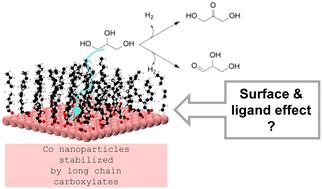长链羧酸配体在Co修饰纳米颗粒催化甘油脱氢中的作用
IF 4.2
3区 化学
Q2 CHEMISTRY, PHYSICAL
引用次数: 0
摘要
醇类无受体脱氢是一种绿色工艺,可获得醛类、酮类和H2等多种高附加值产品。修饰Co纳米颗粒在该反应中表现出良好的催化活性。在该催化体系中,长链羧酸配体的存在保护了Co纳米颗粒的聚集和氧化,并稳定了它们的形状。最活跃的形状是纳米棒,主要暴露Co(0001)和Co(11−20)表面。本文提出了经典分子动力学和DFT相结合的方法,以更好地理解修饰Co纳米棒作为甘油脱氢催化剂时羧酸配体的作用。经典分子动力学模拟提供了界面上的自由吸附能作为两个主要暴露面Co(0001)和Co(11−20)上配体表面覆盖率的函数。这使我们能够确定活性位点周围羧酸配体的可能组织,使用DFT来研究甘油脱氢成二羟基丙酮(DHA)或甘油醛(GLYA)在两个暴露面上的活性和选择性。我们发现,热力学产物DHA被预测为主导产物。原始Co(11−20)和修饰Co(0001)是最活跃的表面,这表明配体的存在可以改变反应的结构敏感性,在设计用作催化剂的形状修饰金属纳米颗粒时需要考虑到这一效应。本文章由计算机程序翻译,如有差异,请以英文原文为准。

Role of long-chain carboxylate ligands in glycerol dehydrogenation catalyzed by Co decorated nanoparticles†
Acceptorless dehydrogenation of alcohols is a green process to obtain several added-value products such aldehydes and ketones and H2. Decorated Co nanoparticles have shown great catalytic activity in this reaction. In this catalytic system, long-chain carboxylate ligands are present to protect the Co nanoparticles from aggregation and oxidation and to stabilize their shape. The most active shape is as a nanorod, exposing mainly the Co(0001) and Co(11−20) surfaces. We propose here the combination of classical molecular dynamics and DFT to better understand the role of carboxylate ligands when decorated Co nanorods are used as catalysts in glycerol dehydrogenation. Classical molecular dynamics simulations provided the free energy of adsorption at the interface as a function of the ligand surface coverage on the two mainly exposed facets Co(0001) and Co(11−20). This allows us to determine the possible organization of carboxylate ligands around the active site using DFT to investigate the activity and selectivity of glycerol dehydrogenation into dihydroxyacetone (DHA) or glyceraldehyde (GLYA) on the two exposed facets. We found that DHA, which is the thermodynamic product, is predicted to be the dominant product. Pristine Co(11−20) and decorated Co(0001) are the most active surfaces, showing that the presence of ligands can alter the structure sensitivity of a reaction, an effect that needs to be taken into account in the design of shaped decorated metallic nanoparticles to be used as catalysts.
求助全文
通过发布文献求助,成功后即可免费获取论文全文。
去求助
来源期刊

Catalysis Science & Technology
CHEMISTRY, PHYSICAL-
CiteScore
8.70
自引率
6.00%
发文量
587
审稿时长
1.5 months
期刊介绍:
A multidisciplinary journal focusing on cutting edge research across all fundamental science and technological aspects of catalysis.
Editor-in-chief: Bert Weckhuysen
Impact factor: 5.0
Time to first decision (peer reviewed only): 31 days
 求助内容:
求助内容: 应助结果提醒方式:
应助结果提醒方式:


